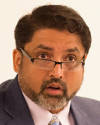by Amyn M Amlani, PhD
The World Health Organization (WHO) estimates that 432 million adults, globally, exhibit “disabled” impaired hearing, where disabled is defined as audiometric thresholds greater than 40 dB in the better ear. An additional estimated 1.1 billion listeners worldwide—ranging in age between 12 and 35 years—are at-risk of demonstrating impaired hearing because of high-level exposure stemming from recreational activities.
The WHO further reports that untreated hearing deficits result in annual global costs of roughly US$750 billion. These costs include expenses related to health care, educational support, loss of productivity, and societal costs. Predictably, these costs do not include the expense of acquiring hearing devices.
Despite the high prevalence of global hearing impairment, and the adverse associated impact of this public health issue on quality of life (e.g., reduced self-image, decreased social interactions, diminished mental health, increased economic costs), hearing healthcare (HHC), generally, is poorly accessed.1,2 The development and integration of technology-innovated, automated hearing screeners offers an opportunity to improve healthcare access and, potentially, compliance to provider recommendations, for impaired listeners.
Technology-Innovations for Healthcare Access
Innovations that provide access to hearing healthcare include technologies such as telephone-based screenings,3 online-based screenings,4 and mobile apps.5 These innovations are automated, and provide information and recommendations tailored to the needs of the individual user, with the intent of enabling successive HHC.
For impaired listeners who reside in rural and isolated areas, or in low- and middle-income countries, technology-driven screening solutions provide the added benefit of providing large-scale access to individuals who otherwise would not be identified. The challenge for this population sample is providing affordable, accessible, quality treatment options.6,7
How Technology-Innovations Drive Compliance
Technology-driven hearing screeners appear to motivate listeners with hearing difficulties to seek help earlier in their patient journey. Smits and colleagues,8 for instance, found that >50% of participants who performed poorly on an online-based, digits-in-noise screening test, complied with recommendations for treatment by a family physician, ENT specialist, audiologist, or hearing-instrument dispenser.
Likewise, Meyer et al9 reported that 36% of participants who failed a telephone-based hearing screening moved forward with HHC treatment. In comparison, traditional, audiometric hearing screenings result in < 20% compliance to provider recommendations.10,11
Technology-Innovation Economics
Linssen and colleagues12 evaluated the cost-effectiveness of screening hearing sensitivity in Dutch listeners aged 50 to 70 years utilizing a Markov model. They compared:
- Telephone screening
- Internet screening
- Screening with a handheld screening device, and
- Audiometric screening across age.
Results revealed that, from a cost-effectiveness standpoint, Internet screening, starting at age 50 years and screening in five-year intervals, yielded the greatest cost-effective strategy. The telephone screening strategy was a close second in the analysis. Lesser, and more costly, were the strategies of screening with a handheld screening device and audiometric screening.
Mobile-app, or smartphone-based, technology, offers increased access, portability, and prompt connection to the provider and screening outcomes. Research indicates that a mobile-app technology designed for a listener to self-screen their hearing sensitivity promotes increased self-efficacy towards HHC treatment by a ratio of 2:1 when compared to the traditional, audiometric hearing screening.13
Summary
The development and deployment of automated hearing screeners is not intended to replace standard pure-tone audiometry nor the services provided by the provider; it should be utilized as part of a larger, hearing wellness program. As such, this wellness program, supported by these technology innovations, offers the public at-large an increased awareness of hearing impairment and its consequences if left untreated.
For impaired listeners, this technology promotes an economic funnel towards earlier HHC intervention. The concept of this funnel is important economically considering the increasing demand for hearing healthcare services in the coming decades and the unmet supply of professionals entering the profession.14,15
References
- Lin FR, Thorpe R, Gordon-Salant S, Ferrucci L. (2011). Hearing loss prevalence and risk factors among older adults in the United States. J Gerontol A Biol Sci Med Sci, 66(5):582–590.
- Nash SD, Cruickshanks KJ, Huang GH, Klein BE, Klein R, Nieto FJ, Tweed TS. (2013). Unmet hearing health care needs: The Beaver Dam offspring study. Am J Public Health,103(6):1134–1139.
- Meyer C, Hickson L, Khan A, Hartley D, Dillon H, Seymour J. (2011). Investigation of the actions taken by adults who failed a telephone-based hearing screen. Ear Hear, 32(6):720–731.
- Saunders GH, Vachhani J, Galvez G, Griest S. (2015). Formative evaluation of a multimedia self-administered computerized hearing loss prevention program. Int J Audiol, 54(4):234–240.
- Swanepoel de W, Myburgh HC, Howe DM, Mahomed F, Eikelboom RH. (2014). Smartphone hearing screening with integrated quality control and data management. Int J Audiol, 53(12):841–849.
- Goins RT, Williams KA, Carter MW, Spencer M, Solovieva T. (2005). Perceived barriers to health care access among rural older adults: A qualitative study. J Rural Health, 21(3):206–213.
- Mulwafu W, Ensink R, Kuper H, Fagan J. (2017). Survey of ENT services in sub-Saharan Africa: Little progress between 2009 and 2015. Global Health Action, 10(1): 1289736.
- Smits C, Merkus P, Houtgast T. (2006). How we do it: the Dutch functional hearing-screening tests by telephone and internet. Clin Otolaryng,, 31(5):436–440.
- Meyer C, Hickson L, Khan A, Hartley D, Dillon H, Seymour J. (2011). Investigation of the actions taken by adults who failed a telephone-based hearing screen. Ear Hear, 32(6):720–731.
- Milstein D, Weinstein BE. (2002). Effects of information sharing on follow-up after hearing screening for older adults. J Acad Rehab Audiol, 35:43-58.
- 10. Thodi C, Parazzini M, Kramer SE, Davis A, Stenfelt S, Janssen T, Smith P, Stephens D, Pronk M, Anteunis L, Schirkonyer V, Grandori F. (2013). Adult hearing screening: Follow-up and outcomes 1. Am J Audiol, 22:183-185.
- Linssen AM, Anteunis LJC, Joore MA. (2015). The cost-effectiveness of different hearing screening strategies for 50- to 70-year-old adults: A Markov model. Value Health, 18:560-569.
- Amlani AM. (2015). Improving patient compliance to hearing healthcare services and treatment through self-efficacy and smartphone applications. Hearing Rev, 21(2):16-22.
- Swanepoel D, Clark JL, Koekemoer D, Hall JW, Krumm M, Ferrari D, McPherson B, Olusanya B, Mars M, Russo I, Barajas J. (2010). Telehealth in audiology—the need and potential to reach underserved communities. Int J Audiol, 49:195-202.
- Windmill IM, Freeman BA. (2013). Demand for audiology services: 30-year projections and impact on academic programs. J Am Acad Audiol, 25:407-416.
About the Author:
 Amyn M. Amlani, PhD, is the Director of New Practice Development at Audigy, a data-driven, management group for audiology and hearing care, ENT group, and allergy practices in the US. Prior to this position, Dr. Amlani was an academician for nearly two decades. He also serves as section editor of Economics for Hearing Health & Technology Matters
Amyn M. Amlani, PhD, is the Director of New Practice Development at Audigy, a data-driven, management group for audiology and hearing care, ENT group, and allergy practices in the US. Prior to this position, Dr. Amlani was an academician for nearly two decades. He also serves as section editor of Economics for Hearing Health & Technology Matters






